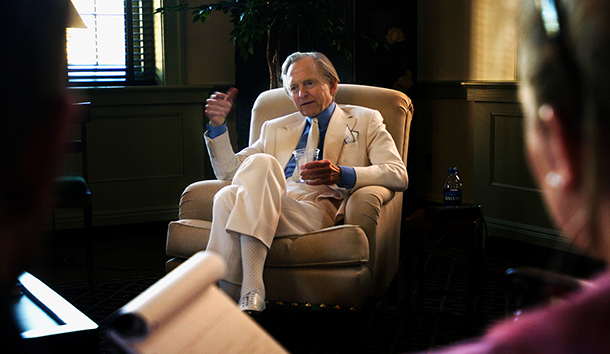When Tom Wolfe’s debut novel, The Bonfire of the Vanities, was published in November 1987, the book was greeted with effusive praise and became a best-seller, although some literati seemed offended by Wolfe’s highly descriptive prose, the hyperbole, exuberant punctuation, and occasional sound effects. After film rights were sold for $750,000 that winter to Peter Guber and Jon Peters, who had a production deal with Warner Bros., Wolfe made it clear that he wanted nothing to do with the making of the movie itself. “I think it’s bad manners in the Southern sense to be sharp and critical of it,” he said of the movie interest. “I did cash the check.” He pointed out that,
The way I constructed the book, almost every chapter was meant to be a vignette of something else in New York as well as something that might advance the story, and to me one was as important as the other. . . . Not that I gave very much thought to how the movie could be made, but I never could see how you could do that.
The movie, which appeared in 1990, was an expensive flop, while, today, The Bonfire of the Vanities is accepted as a major novel, vintage Tom Wolfe in its richly detailed depiction of a late-1980’s New York City culture of snobbery, ego, and vanity in which bad taste and a craving for status had gone amok, much as his hilarious 1970 New York piece “Radical Chic: That Party at Lenny’s,” about conductor Leonard Bernstein’s cocktail reception for the Black Panthers, had lampooned that era’s wealthy liberal pretensions to virtue. Later novels A Man in Full (1998), I Am Charlotte Simmons (2004), and Back to Blood (2012) pinpointed other cultural and social settings—Atlanta real estate, liberal-arts colleges, Miami corruption and multiethnicity—as masterly as his 1979 nonfiction National Book Award winner The Right Stuffhad described the world of astronauts.
Wolfe was a traditionalist, an anachronism, and an original all at once. The immaculate vanilla suits and handmade shoes with faux spats, the high-necked shirts, neckties, and pocket display handkerchiefs—a look he once jovially described as “neo-pretentious”—and gracious Southern-inflected speech reflected old-guard gentility and elegance. A 1951 cum laude graduate of Washington and Lee University in his native Virginia, he once told this writer (also a W&L grad) that he was miffed when the college did away with its long-standing coat-and-tie dress code in the early 1970’s. Yet by then he had already taken part in a journalistic revolution as, after coming to New York City in 1962, he helped create and name the “New Journalism,” based on his theory that journalism and nonfiction had eclipsed the novel in American literature. Wolfe, Gay Talese, Jimmy Breslin, Hunter Thompson, and others were the vanguard of this new style noteworthy for its novelistic attention to detail, opulence of language, humor, and scene-by-scene narrative in which the writer/reporter was often a virtual participant.
Although he was praised by such conservative stalwarts as William F. Buckley, Jr., and Joseph Epstein, Wolfe’s flamboyant dress and writing style made him the natural target of a New York intelligentsia resentful of his success and of his reverence for Dickens, Zola, and Balzac and who panned his fiction as puffed-up journalism. He was forced to endure a lot of guff from the mandarins of the art world for his 1975 nonfiction book The Painted Word, in which he denounced contemporary art as a con and a racket perpetrated by a handful of elitist, self-infatuated critics, and from architecture insiders furious over his 1981 book From Bauhaus to Our House, where he dismissed modern architecture as soulless. He usually brushed off petty comments from the likes of John Updike, John Irving, Norman Mailer, and others, but sometimes might retaliate later, as he did in a magazine article titled “My Three Stooges.” Along with the novels he contributed colorful magazine pieces and drawings to New York, Esquire, Harper’s, Rolling Stone, and other publications, poking fun at a wide variety of subjects including surfers, patterns of speech, pornography, writers’ conferences, literary receptions, the scene on Martha’s Vineyard, and Sigmund Freud, and baptized such cultural phenomena as “Radical Chic,” “Funky Chic,” and “The Me Decade” in idioms that remain in force today.
He loved America, once lauding the United States as
the greatest nation that has ever existed, still is. It’s really the only really democratic country in the world. Find me one country, just one country, in the entire world that would let a foreign people—different culture, different language, and in many cases different color [from] the majority of the native stock—take over politically an entire metropolitan area in less than one generation. I’m talking about the Cubans in Miami . . .
And he worked, setting himself a daily goal of ten pages, however long it took him and wherever he was. Now he is gone at age 88. In this age of cookie-cutter fiction, group-think pundits who deride patriotism, Fake News disguised as journalism, and copycat slovenly dress—an age in which it has become fashionable to extol mediocre talent as genius—Tom Wolfe’s playful, richly descriptive prose was the essence of originality, and in his personal style he was sui generis in the flesh. To paraphrase his own title, he was “the real stuff,” and will be missed.

Leave a Reply